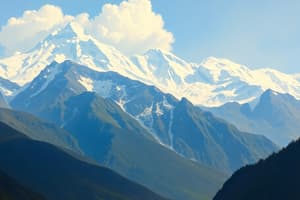Podcast
Questions and Answers
Which river systems contribute to the formation of the Northern Plain?
Which river systems contribute to the formation of the Northern Plain?
What is the significance of the soil in the Northern Plain?
What is the significance of the soil in the Northern Plain?
What are doabs, and how do they relate to the Punjab Plains?
What are doabs, and how do they relate to the Punjab Plains?
Which region lies between the Teesta and Dihang rivers?
Which region lies between the Teesta and Dihang rivers?
Signup and view all the answers
How many square kilometers does the Northern Plain cover approximately?
How many square kilometers does the Northern Plain cover approximately?
Signup and view all the answers
Which statement accurately reflects the topographical features of the Peninsular Plateau?
Which statement accurately reflects the topographical features of the Peninsular Plateau?
Signup and view all the answers
What geological characteristic of the Himalayas distinguishes them from the Northern Plains?
What geological characteristic of the Himalayas distinguishes them from the Northern Plains?
Signup and view all the answers
What is a unique feature of the Himalayan Mountain range in terms of its geographical layout?
What is a unique feature of the Himalayan Mountain range in terms of its geographical layout?
Signup and view all the answers
What distinguishes the youthful topography of the Himalayas?
What distinguishes the youthful topography of the Himalayas?
Signup and view all the answers
What is the primary composition of the Northern Plains?
What is the primary composition of the Northern Plains?
Signup and view all the answers
Study Notes
Rivers and Regions
- Kali and Teesta rivers define the boundary between the Nepal Himalayas and the Assam Himalayas, with the region between the Teesta and Dihang rivers termed Assam Himalayas.
Northern Plains
- Formed by the Indus, Ganga, and Brahmaputra river systems and their tributaries, consisting primarily of alluvial soil.
- The Northern Plain extends over an area of 7 lakh sq.km, approximately 2400 km long and 240 to 320 km wide.
- Rich soil and favorable climate make this region agriculturally productive.
- Punjab Plains are part of the Northern Plain and derived from the Indus and its tributaries including Jhelum, Chenab, Ravi, Beas, and Satluj, mainly lying in Pakistan.
- Ganga Plain stretches between Ghaggar and Teesta rivers, encompassing North India across multiple states including Haryana, Delhi, U.P., Bihar, Jharkhand, and West Bengal.
- Brahmaputra Plain is located in the eastern region, particularly in Assam.
Himalayan Mountains
- The Himalayas are young, structurally fold mountains that arc over 2400 km from the Indus to the Brahmaputra.
- Width varies from 400 km in Kashmir to 150 km in Arunachal Pradesh.
- Features significant altitudinal variations, particularly more pronounced in the eastern half.
- Divided into three parallel ranges, with valleys situated between the ranges.
- Characterized by high peaks, deep valleys, and fast-flowing rivers, representing a youthful topography.
Peninsular Plateau
- A tableland made of old crystalline, igneous, and metamorphic rocks, formed from the tectonic breakup of Gondwana land.
- Characterized by broad, shallow valleys and rounded hills, divided into Central Highlands and Deccan Plateau.
- Northern part (Central Highlands) lies above the Narmada river, while Deccan Plateau features higher elevations toward the west, gradually sloping eastward.
- Includes notable extensions like the Meghalaya, Karbi-Anglong Plateau, and North Cachar Hills.
Western and Eastern Ghats
- Western Ghats run parallel to the western coast, continuously formed with higher elevations (900-1600 meters).
- Eastern Ghats are discontinuous, lower in height (approximately 600 meters), and erratic.
- The Western Ghats induce orographic rain, due to moist winds rising along their western slopes, while notable peaks include Anai Mudi and Doda Betta.
Coastal Plains
- Northern part of the Bay of Bengal coastline referred to as Northern Circar, southern part as Coromandel Coast.
- Formed by large rivers such as Mahanadi, Godavari, Krishna, and Kaveri creating extensive deltas.
- Chilika Lake in Odisha is the largest saltwater lake in India, located south of the Mahanadi delta.
Islands
- India has two main groups of islands: Andaman Islands and Nicobar Islands.
- They form a chain across the Bay of Bengal, believed to be elevated submarine mountains, with strategic importance for the country.
Studying That Suits You
Use AI to generate personalized quizzes and flashcards to suit your learning preferences.
Related Documents
Description
This quiz focuses on the geographical features and regional distinctions of the Himalayas, particularly the Kali, Teesta, and Dihang rivers, as well as the Northern Plain of India. Explore the unique characteristics and classifications of these important landforms in the context of contemporary geography.




